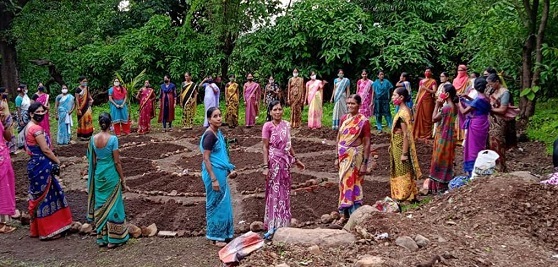SHOBHA SHUKLA

Although the world gave unprecedented attention to the COVID-19 pandemic, yet it has long ignored paying heed to one of the most widespread violations of human rights globally: sexual and other forms of gender-based violence – a shadow pandemic that has been menacingly lurking since long. May be it is the deep-seated patriarchy and its sinister links with capitalism and religious fundamentalism that prevents us from ending all forms of violence against women and girls, and other people of different gender identities and expressions.
When danger is from those who are closest to us
At least one in every three women in countries of Asia and the Pacific have suffered one or more forms of gender-based violence – which includes intimate partner violence. 19% of women in South Asia, 9% in Southeast Asia and between 19% and 30% in the Pacific had experienced physical and /or sexual intimate partner violence in the past 12 months (as per 2018 data). Lifetime prevalence of intimate partner violence is as high as 53% in Kiribati and 50% in the Solomon Islands.
Access to women’s health services way off-the-mark
The world invested a fortune in finding vaccines against COVID-19, and rolling them out. But despite having the know-how, why are we failing to ensure every woman and girl has full access to sexual and reproductive health services with dignity?
Although India’s total fertility rate has declined to 2.2, maternal mortality ratio (deaths per 100,000 live births) remains high at 97. Almost 20% births are not attended by skilled health personnel; 27% girls get married before the age of 18 and unintended pregnancy rate per 1000 women aged 15-49 years is 62, as per UNFPA data.

In neighbouring Pakistan, fertility rate is high at 3.3; and so is maternal mortality ratio at 140. Almost 30% births are not attended by skilled health personnel, Unintended pregnancy rate per 1,000 women is 71. 18% of the girls get married by the age of 18 years.
Professor Aziz-un-Nisa Abbasi, Dean and Professor of Obstetrics and Gynaecology, Department of Ayub Medical College of Abbottabad, and President of Society of Obstetricians and Gynaecologists of Pakistan said that contraceptive prevalence rate has stagnated and family planning uptake is dismally low even in urban areas at 35% and 5-10% in rural areas.
According to Prof Aziz-un-Nisa Abbasi, “Oral contraceptive pills and intra-uterine contraceptive devices are not popular, as most of the women are not educated enough to take them. But nowadays we are promoting postpartum and post-abortion family planning. We mostly advocate for postpartum long-acting reversible contraception procedures and also sterilisation in case of caesarean deliveries (after 3-4 deliveries)”.
80-90% pregnancies in Pakistan are unplanned. Abortion is not legalised and termination of pregnancy is allowed only on medical grounds if there is any abnormality in the unborn child.
Prof Abbasi told CNS (Citizen News Service) that “the spontaneous abortion rate is 10-15% but termination of pregnancy rate is very low. However, women do take Misoprostol (that is available over the counter) to terminate pregnancy. But very often they return to us with complications. They also get abortions done clandestinely through midwives, nurses and even doctors. Also, while women are screened for Hepatitis B and Hepatitis C, enough HIV screening in them is not done. STI prevalence is not high, perhaps due to adherence to religious rules and also because of under testing. We do syndromic management of STIs as we cannot screen for infections like Chlamydia due to resource constraints.”

Worrying situation of women’s health in Papua New Guinea
Fertility rate in Papua New Guinea is high at 3.4 and maternal mortality ratio is also very high at 145. 27% of the girls get married before the age of 18 and the unintended pregnancy rate per 1,000 women is 80.
With less than 40% of pregnant women having access to supervised birthing care, the situation in Papua New Guinea is poor indeed. Professor Glen Mola, Head of Obstetrics and Gynaecology at the School of Medicine and Health Sciences at Port Moresby General Hospital of Papua New Guinea, and senior office bearer of Papua New Guinea Society of Obstetrics and Gynaecology, spoke to CNS.
Prof Mola is candidly worried about the poor state of women’s health in his country. He shared that contraceptive prevalence rates in Papua New Guinea are stuck at mid to high 20%. It also has very high rates of chlamydia, gonorrhoea and syphilis infections. Chlamydia rates are about 25% in antenatal populations in community surveys though these rates are much higher in STI clinics at 30-40%. Syphilis rates vary from 1-2% in coastal areas to 5-10% in the highlands. HIV infections too have climbed from 2% to 3% during the last few years.
In Papua New Guinea even getting condoms is not easy. “People are embarrassed about requesting a condom especially as most of the healthcare workers are women. So it is difficult for young men to go to a female health worker and request condoms. Also there is an undercurrent in healthcare workers that condoms are bad as they promote promiscuity. They forget that condoms are for safety and risk mitigation” said Prof Mola.
He rightly suggests that condoms should be kept in an open box at the front reception desk of every health facility so that those who want them can take as many as they need without asking or feeling embarrassed. And nurses should record the total number of condoms taken away (and not record names of clients and how many each took).
One success story he cites is that recently Papua New Guinea has instituted immediate postpartum family planning, mainly with contraceptive implants as well as postpartum sterilisation.
“Counselling for implants is done antenatally so that when the woman comes for supervised birth she is mentally prepared for it. Our demographic health survey shows clearly that the family size in Papua New Guinea is always about one more than what they want. The main problem is misinformation and misconceptions around family planning- like ‘implants cause cancer’ and/or ‘interfere with sexual activity’. So we have to counsel and re-counsel women when they request for removal of their implants after just a couple of months because of rumours they hear in the community” shared Prof Mola.
He called for “integrating family planning services with general healthcare – and not confine it to maternal healthcare only – in order to improve the situation. Access to general healthcare is vital to have effective family planning services. If we do better on other social fronts, family planning will come along with it”.
In the words of Tomoko Fukuda, International Planned Parenthood Federation (IPPF)’s Regional Director for East and South-East Asia and Oceania Region, “The main challenge is reaching out to all the diverse groups of women – single women, young women, women with disabilities, women living in remote areas. Family planning is not just about the family but about a woman’s choices and rights to control her life, and how to prevent STIs and unplanned pregnancies. It is about young girls and women to lead a full and productive life”.
Sustainable development can only be achieved if women have autonomy over their bodies. It is only when women and girls across the region can make informed decisions about their sexual and reproductive health, will they be able to lead a healthy and productive life. – CNS
